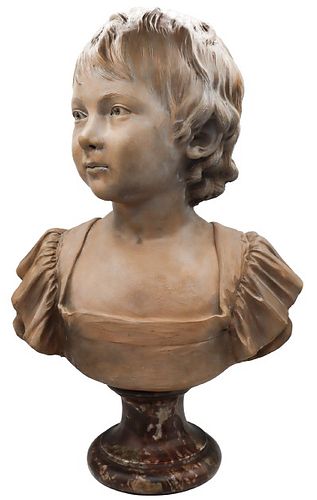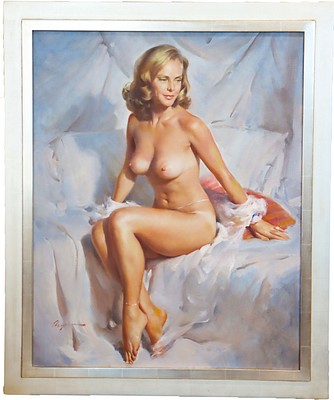Jean-Antoine Houdon (1741-1828) Terracotta Bust
About Seller
522 South Pineapple Avenue
Sarasota, FL 34236
United States
Sarasota Estate Auction specializes in a wide variety of furniture, antiques, fine art, lighting, sculptures, and collectibles. Andrew Ford, owner and operator of the company, has a passion for finding the best pieces of art and antiques and sharing those finds with the Gulf Coast of Florida.
Two ways to bid:
- Leave a max absentee bid and the platform will bid on your behalf up to your maximum bid during the live auction.
- Bid live during the auction and your bids will be submitted real-time to the auctioneer.
Bid Increments
| Price | Bid Increment |
|---|---|
| $0 | $10 |
| $100 | $25 |
| $250 | $50 |
| $1,000 | $100 |
| $2,500 | $250 |
| $7,500 | $500 |
| $20,000 | $1,000 |
| $50,000 | $2,500 |
| $100,000 | $5,000 |
| $250,000 | $10,000 |
About Auction
Nov 15, 2020
Fall Fine Art and Antiques Extravaganza Sarasota Estate Auction sarasotaestateauction@gmail.com
- Lot Description
Terracotta bust of a young girl with brown patina. Original brown marble base. Signed and dated 1783 on underside. Slight flake to the back of the sculpture. Prominent in France during the Enlightenment period of the late 18th and early 19th centuries, Jean-Antoine Houdon was a neo-classical sculptor, especially noted for his marble portrait busts and statues. His subjects included Americans Benjamin Franklin, George Washington, Thomas Jefferson, and Robert Fulton, and among his French subjects were Denis Diderot, Jean-Jacques Rousseau, Louis XVI and Napoléon Bonaparte. For King Louis, he did numerous statues for the gardens of Versailles. Houdon was a continuous exhibitor at the French Salon, and works included many of the above mentioned personages as well as Prince Henry of Prussia, Catharine of Russia, Voltaire, the playwright Moliere and Marshal de Tourville. Houdon was born in Versailles in 1714. His artistic talent was apparent from the time he was young, and at age 12, he enrolled in the Ecole Royale de Sculpture where he was a student of sculptor Michel Ange Slodtz (1705-1764). In 1761, at the age of 20, Houdon received a Prix de Rome, which was a scholarship sponsored and paid for by the King of France for art students to study at The Academy of France in Rome. He stayed in Italy for ten years, and there much delighted Pope Clement XIV and many other people with his statue of St. Bruno, which Houdon did for the church of St. Maria degli Angeli. Although receiving the Prix de Rome brought him public recognition and the duration provided some excellent exposure to Italian art, scholars indicate that he was not particularly influenced by either the Renaissance or Classical works. However, tangible evidence of some of that influence was the sculpture he titled Morpheus that he sent to the French Salon in 1771. That same year, because of the skill he had shown with Morpheus, and with entries two years earlier that were busts of Catharine II, Diderot and Prince Galitzin, Houdon was elected to the Académie des Beaux-Arts (painting and sculpture), one of the five academies of the Institute de France, a society of learned persons who set aesthetic standards. In 1778, he became a Professor at the Académie and has been described as being a very active teacher. During the French Revolution, he was censored as a 'bourgeois' because of his association with Louis XVI, but he was not imprisoned. Under the French Consulate, the government between 1799 and 1804, and the French Empire, 1804-1814, when Napoléon took over, Houdon regained his former stature. He executed architectural reliefs, did a statue of Cicero for the Senate, did portrait busts of Napoleon and his wife Josephine, and received the Legion of Honour. In 1785, at the invitation of Benjamin Franklin, America's Minister to France, Houdon traveled with Franklin to America to Virginia, where he visited Mount Vernon to model George Washington, who four years later would be elected President of the United States. From sittings, Houdon made wet-clay life models and a plaster life mask, which later were used, not only by Houdon in Paris for his portrait bust of Washington but for many sculpture works of Washington. Among these Washington subjects are the standing figure statue in the state capitol building in Richmond commissioned by the Virginia General Assembly; many variations of a portrait busts, and a statue in the Vermont State House depicting him in a toga as the Roman Consul Lucius Quinctius Cincinnatus. Jean-Antoine Houdon died in Paris July 16, 1828, and is buried in Montparnasse Cemetery. From November 4, 2003 to January 25, 2004, an exhibition of Houdon's sculpture was held at the J. Paul Getty Museum in Los Angeles. Size: 18 x 12 x 6 in.
- Shipping Info
-
SHIPPING INFORMATION·
Sarasota Estate Auction IS NOT RESPONSIBLE FOR SHIPPING. All shipping will be handled by the winning bidder. Sarasota Estate Auction recommends obtaining shipping quotes before bidding on any items in our auctions. If you are interested in obtaining any information on local shippers, please send us an email and we will kindly send you a list of local shippers. Once payment for an item has been paid to the auction house we release the items to the shippers we recommend on the invoice immediately unless otherwise noted by the buyer. Refunds are not offered under any circumstances base on shipping issues, this is up to the buyer to arrange this beforehand.
PakMail
941-751-2070
Paktara266@gmail.com
UPS Store 4074
(941) 358-7022
Store4074@theupsstore.com
-
- Payment & Auction Policies
-
Available payment options
We accept all major credit cards, wire transfers, money orders, checks and PayPal. Please give us a call at (941) 359-8700 or email us at SarasotaEstateAuction@gmail.com to take care of your payments.
-
- Buyer's Premium



 EUR
EUR CAD
CAD AUD
AUD GBP
GBP MXN
MXN HKD
HKD CNY
CNY MYR
MYR SEK
SEK SGD
SGD CHF
CHF THB
THB



















